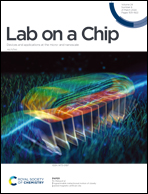Endocrine-disrupting compounds and their impact on human placental function: evidence from placenta organ-on-chip studies†
Abstract
The effects of endocrine-disrupting compounds (EDCs) on the placenta, a critical gestational organ for xenobiotic protection, are well reported; however, models to determine the role of EDCs in placental disruption are limited. An advanced 2nd-trimester human placenta organ-on-chip model (2TPLA-OOC) was developed and validated, with six representative cells of the maternal and the fetal interface interconnected with microchannels. Various EDCs (150 ng mL−1 each of bisphenol A, bisphenol S, and polybrominated diphenyl ethers-47 and -99) were gradually propagated across the chip for 72 hours, and their various effects were determined. Cigarette smoke extract (CSE), an environmental risk factor, was used as a positive control. EDCs produced overall oxidative stress in the placental/decidual cells, induced cell-specific endocrine effects, caused limited (<10%) apoptosis/necrosis in trophoblasts and mesenchymal cells, induced localized inflammation but an overall anti-inflammatory shift, did not change immune cell migration from stroma to decidua, and did not affect placental nutrient transport. Overall, (1) the humanized 2TPLA-OOC recreated the placental organ and generated data distinct from the trophoblast and other cells studied in isolation, and (2) at doses associated with adverse pregnancies, EDCs produced limited and localized insults, and the whole organ compensated for the exposure.



 Please wait while we load your content...
Please wait while we load your content...